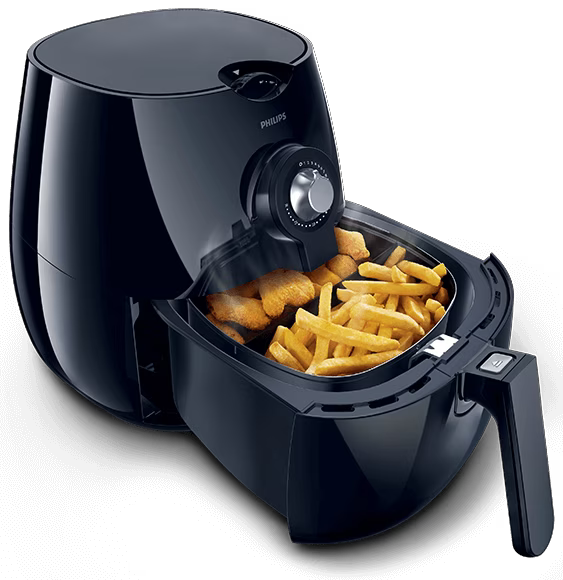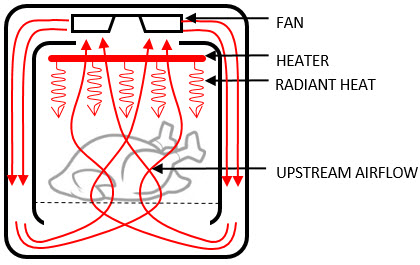By Adven Simarmata. Last updated on September 28th, 2023.
History of Air Fryers

The concept of air fryers was first developed in 2007 by APDS, a small product development firm from the Netherlands.[1] In early 2009, APDS presented their invention to a large health technology company, Philips.[2] After Philips investigated the product idea and was satisfied with the result, they signed a licensing agreement with APDS.[2] In 2010, Philips launched and introduced the air fryer as a new kitchen appliance at a consumer electronics fair in Berlin.[2] Since then, Philips started to sell air fryers, and more than 5 million units were sold worldwide five years after its introduction in Berlin.[1] Many other companies then made their versions of air fryers, which were derived from the original concept developed by APDS.
APDS named the technology used in air fryers RUSH (Radiant UpStream Heating), but then Philips named it Rapid Air technology.
Working Principle of Air Fryers

As the original name of the technology, RUSH (Radiant UpStream Heating), suggests, the air fryers transfer heat to the food by using two types of heat, radiant heat and “upstream” convection heat.[3] The radiant heat comes from the heating element; it radiates down toward the food, as shown in Figure 2. The function of the fan is to create hot air streams that flow toward the food through the open bottom of the food chamber; this is where the “upstream” convection heat comes from. This combination of streams of heat intensely heats the food from all sides, similar to when the food is deep-fried with a bunch of oil.
Air fryers cook the food in a similar way to convection ovens, but in a faster way just like deep-frying in oil. Oil transfers heat much faster than air does. However, moving the air particles can significantly increase the rate of heat transfer in the air, and this is exactly what air fryers do. The moving of air is done by putting a fan at the top of the food chamber and a star-shaped guide profile below the food chamber. These two components work together to move the hot air and direct it to precisely pass over the food and heater surface. The star-shaped guide profile also makes sure the airflow is distributed evenly over the bottom side of the food. With this technique, the texture of the food that is mainly cooked with hot air in air fryers is comparable to the food that is mainly cooked with hot oil.
Advantages of Using Air Fryers
Air fryers offer some advantages over other cooking appliances, especially deep fryers, that are worth considering.
1. Healthier than Frying with Oil
In general, “frying” using air fryers is healthier than deep-frying in oil because air-frying requires little or no oil.[4] A comparative study done by Carla Santos et al. (2017) found that air-fried potatoes contain an average of 70% less fat than the same quantity of deep-fried potatoes, which leads to a reduction of calories of 45 kcal per 100 g.[5]
2. Less Smelly and Easier to Clean
Because it uses minimal oil to cook the food, it contains less odor, and the pan is easier to clean. The pan and basket of some brands of air fryers, like Philips air fryers, can even be cleaned in the dishwasher.[6]
3. Multi-function
Not only great for frying, but Philips air fryers can also bake, roast, and grill.[4] They can cook a large range of ingredients, such as nuggets, fries, steak, chicken, stuffed vegetables, cake, and many others.
Important Cautions
Remember to read thoroughly the user manual of the air fryer you purchase to ensure safe usage. Listed below are the most important things you need to take note of before using your air fryer. This list of cautions is taken from the Philips air fryer user manual,[6] which more or less applies to air fryers from other brands as well.
- You should not fill the pan with too much oil, frying fat, or any other liquid, since the abundant liquid may cause a fire hazard. Remember that air fryers use hot air to cook the food. You can only put little oil, e.g. by brushing on the surface of the food.
- Make sure the color of the cooked food is golden yellow instead of dark brown. Remove burnt remnants if there are any. You also need to avoid frying fresh potatoes above 180 degrees Celsius to minimize the production of acrylamide.
- Philips air fryers use a non-stick coating in their pan, basket, baking tray, and the inside of the appliance. You should not use abrasive materials, such as metal, to clean the surface of those parts because it may damage the non-stick coating.
- Certain types of food, such as fries, need to be shaken in the frying process to make sure it is cooked evenly.
- Don’t touch the body of the pan with a bare hand some time after use as it is still hot. However, you can hold the pan by the handle directly after use since it is insulated.
The cautions listed above are just a few of the many other important things to take note of from the air fryer user manual, so you should read it thoroughly.
Conclusion
Air fryers cook food by transferring two types of heat to the food, which are radiant and convection heat. The radiant heat, coming from the heating element, is passed from the top side of the food. The convection heat, which is rapidly transferred by the moving air, is passed from the bottom side of the food. A star-shaped guide profile helps distribute the convection heat evenly over the food. The combination of these heat transfers results in intense heating of the food from all sides, yielding food that has a texture similar to the texture of deep-fried food, but healthier.
References
- APDS. (n.d.). About Us. Retrieved March 15, 2023, from http://apds.nl/about-us/
- Exnovate. (n.d.). The Airfryer. Retrieved March 15, 2023, from https://www.exnovate.org/airfryer
- APDS. (2016, June 10). What is Rapid Air Technology? Retrieved March 15, 2023, from http://apds.nl/development-en/what-is-rapid-air-technology/
- Philips. (n.d.). Philips Daily Collection Airfryer HD9216/43. Retrieved March 15, 2023, from https://www.philips.co.in/c-p/HD9216_43/daily-collection-airfryer-with-rapid-air-technology#see-all-benefits
- Santos, C. S., Cunha, S. C., & Casal, S. (2017). Deep or air frying? A comparative study with different vegetable oils [Abstract]. European Journal of Lipid Science and Technology, 119(6). doi:10.1002/ejlt.201600375. Retrieved March 15, 2023, from https://onlinelibrary.wiley.com/doi/abs/10.1002/ejlt.201600375
- Philips. (n.d.). User Manual. Retrieved March 15, 2023, from https://www.documents.philips.com/assets/20210424/16a344966b0440e295c3ad1400dba7a8.pdf

Leave a Reply